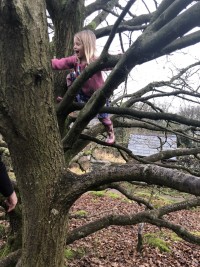How much time a day do our children spend playing freely outside, running, balancing, climbing, hanging upside down, spinning and taking risks? On average, less and less. A study carried out by the National Trust1 revealed that children today spend half the time playing outdoors as their parents did. Demanding school curriculums, a culture of worrying about accidents, an increase in structured after-school activities and the lure of technology could all be contributing factors. Most of us probably feel that outdoor play is important, but why?
much time a day do our children spend playing freely outside, running, balancing, climbing, hanging upside down, spinning and taking risks? On average, less and less. A study carried out by the National Trust1 revealed that children today spend half the time playing outdoors as their parents did. Demanding school curriculums, a culture of worrying about accidents, an increase in structured after-school activities and the lure of technology could all be contributing factors. Most of us probably feel that outdoor play is important, but why?
As well as fuelling children’s imaginations and creativity, boosting vitamin D levels and encouraging an atonement to nature, there are other essential physical benefits to playing outdoors.
Have you heard of proprioception and the vestibular system? Proprioception allows us to know where our body is in space, i.e. where our limbs are without looking at them. It allows us to walk downstairs without looking at the stairs or bounce a ball while looking ahead. The vestibular system is the sensory system based in our inner ear which provides our brain with information about motion and spatial awareness, helping us to balance. To develop both proprioception and the vestibular system, toddlers and children need to spend time climbing, balancing, spinning and turning upside down. If these systems are under-developed, children can have problems with fidgeting, balancing on chairs, spatial awareness, listening and focussing on tasks.2,3 So, it is essential for children to have outdoor, physical free play in order to be able to focus on other learning tasks and aspects of life in general.
The lack of physical activity is also contributing to a decrease in strength among young people. A study published in the Journal of Science and Medicine in Sport4 “found that in 2014, 10-year-olds from a town in the UK had 20% less muscle strength and 30% less muscle endurance than 10-year-olds from that same town 16 years earlier”2.
Glenn and I are conscious of allowing our daughter to take risks (which often takes some willpower!) and we give her as much time as we can to be outdoors in nature or at the park but we are aware that she could very likely benefit from more, so we will keep working on this! Glenn has also given her chiropractic checks and adjustments from birth, simply because we believe in the importance of freeing her nervous system so her entire body can function at its best. However, there is also some fascinating research which suggests that chiropractic care can help with both proprioception and strength.
A study looking at proprioception in people aged 65 or older, showed that after 12 weeks of chiropractic care, there was an improvement in ankle joint position sense error, increased sensorimotor function and improved quality of life related to physical health5.
Another study demonstrates that chiropractic care can increase strength, decrease fatigue and improve muscle drive; the changes noted were “almost identical to three weeks of strength training” (Heidi Haavik, Neuroscientist and Chiropractic Researcher)6.
So, let your children run, climb, spin, roll, hang and fall and why not get them checked by a chiropractor as well? Their experiences and development in their early years will shape their health and their physical and mental abilities throughout adulthood.
Rosalind
- https://www.nationaltrust.org.uk/news/the-humble-stick-revealed-as-the-must-have-toy-for-summer
- https://www.stack.com/a/the-shocking-phenomenon-that-shows-just-how-movement-starved-modern-kids-really-are?fbclid=IwAR2h6ap3etBUhEA-1oKlhrlY318WkCBQBMdJkkubJqn_oogPqEtvfxaKe2A
- https://themilitarywifeandmom.com/why-kids-wont-listen/?fbclid=IwAR27TPmzN_8yt9tN1PybS0wgZQudGm-BtJHb0_A6gSJ2lATEVOlIoog8Qx4
- Sandercock, G. and Cohen, D. (2019). Temporal trends in muscular fitness of English 10-year-olds: An allometric approach. Journal of Science and Medicine in Sport. 22(2), 201-205.
- Holt, K. and Haavik, H. (2016). Effectiveness in chiropractic care to improve sensorimotor function associated with falls risks in older people: A randomized controlled trial. Journal of Manipulative and Physiological Therapeutics. 39(4), 267-278.
- Niazi, I. and Türker, K. et. al (2015). Changes in H-reflex and V-waves following spinal manipulation. Experimental Brain Research. 233, 1165-1173.
